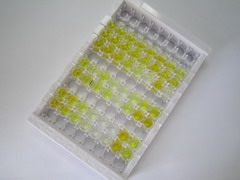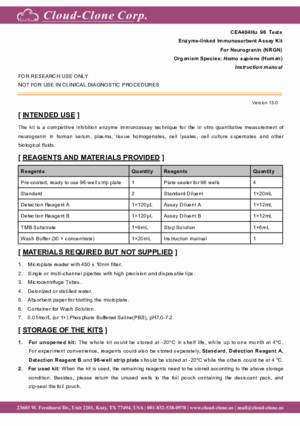Packages (Simulation)

Reagent Preparation

Image (I)
Image (II)
Certificate


ELISA Kit for Neurogranin (NRGN)
Ng; NEUG; Protein Kinase C Substrate RC3
- Product No.CEA404Hu
- Organism SpeciesHomo sapiens (Human) Same name, Different species.
- Sample Typeserum, plasma, tissue homogenates, cell lysates, cell culture supernates and other biological fluids
- Test MethodCompetitive Inhibition
- Assay Length2h
- Detection Range39-10,000pg/mL
- SensitivityThe minimum detectable dose of this kit is typically less than 17pg/mL.
- DownloadInstruction Manual
- UOM 48T96T 96T*5 96T*10 96T*100
- FOB
US$ 441
US$ 630
US$ 2835
US$ 5355
US$ 44100
For more details, please contact local distributors!
Specificity
This assay has high sensitivity and excellent specificity for detection of Neurogranin (NRGN).
No significant cross-reactivity or interference between Neurogranin (NRGN) and analogues was observed.
Precision
Intra-assay Precision (Precision within an assay): 3 samples with low, middle and high level Neurogranin (NRGN) were tested 20 times on one plate, respectively.
Inter-assay Precision (Precision between assays): 3 samples with low, middle and high level Neurogranin (NRGN) were tested on 3 different plates, 8 replicates in each plate.
CV(%) = SD/meanX100
Intra-Assay: CV<10%
Inter-Assay: CV<12%
Stability
The stability of kit is determined by the loss rate of activity. The loss rate of this kit is less than 5% within the expiration date under appropriate storage condition.
To minimize extra influence on the performance, operation procedures and lab conditions, especially room temperature, air humidity, incubator temperature should be strictly controlled. It is also strongly suggested that the whole assay is performed by the same operator from the beginning to the end.
Reagents and materials provided
| Reagents | Quantity | Reagents | Quantity |
| Pre-coated, ready to use 96-well strip plate | 1 | Plate sealer for 96 wells | 4 |
| Standard | 2 | Standard Diluent | 1×20mL |
| Detection Reagent A | 1×120µL | Assay Diluent A | 1×12mL |
| Detection Reagent B | 1×120µL | Assay Diluent B | 1×12mL |
| TMB Substrate | 1×9mL | Stop Solution | 1×6mL |
| Wash Buffer (30 × concentrate) | 1×20mL | Instruction manual | 1 |
Assay procedure summary
1. Prepare all reagents, samples and standards;
2. Add 50µL standard or sample to each well.
And then add 50µL prepared Detection Reagent A immediately.
Shake and mix. Incubate 1 hour at 37°C;
3. Aspirate and wash 3 times;
4. Add 100µL prepared Detection Reagent B. Incubate 30 minutes at 37°C;
5. Aspirate and wash 5 times;
6. Add 90µL Substrate Solution. Incubate 10-20 minutes at 37°C;
7. Add 50µL Stop Solution. Read at 450 nm immediately.
GIVEAWAYS
INCREMENT SERVICES
| Magazine | Citations |
| Alzheimer's & Dementia: Diagnosis, Assessment & Disease Monitoring | Prediction of conversion from mild cognitive impairment to dementia with neuronally derived blood exosome protein profile Pubmed:27408937 |
| Annals of Clinical and Translational Neurology | Plasma neuronal exosomal levels of Alzheimer's disease biomarkers in normal aging Pubmed:27231710 |
| The FASEB Journal | Decreased synaptic proteins in neuronal exosomes of frontotemporal dementia and Alzheimer’s disease pubmed:27601437 |
| Journal of Alzheimer's Disease | Growth Hormone-Releasing Hormone Administration in Mild Cognitive Impairment and Its Impact on Neuronal Exosome Biomarkers of Dementia Doi: 10.3233/JAD-180302 |
| SYNAPTIC PROTEIN BIOMARKERS AND DIFFERENTIAL DIAGNOSIS OF ALZHEIMER'S DISEASE AND OTHER NEURODEGENERATIVE DISORDERS | |
| Am J Emerg Med | The diagnostic value of neurogranin in patients with carbon monoxide poisoning: Can it show early neurological damage? 34388687 |















